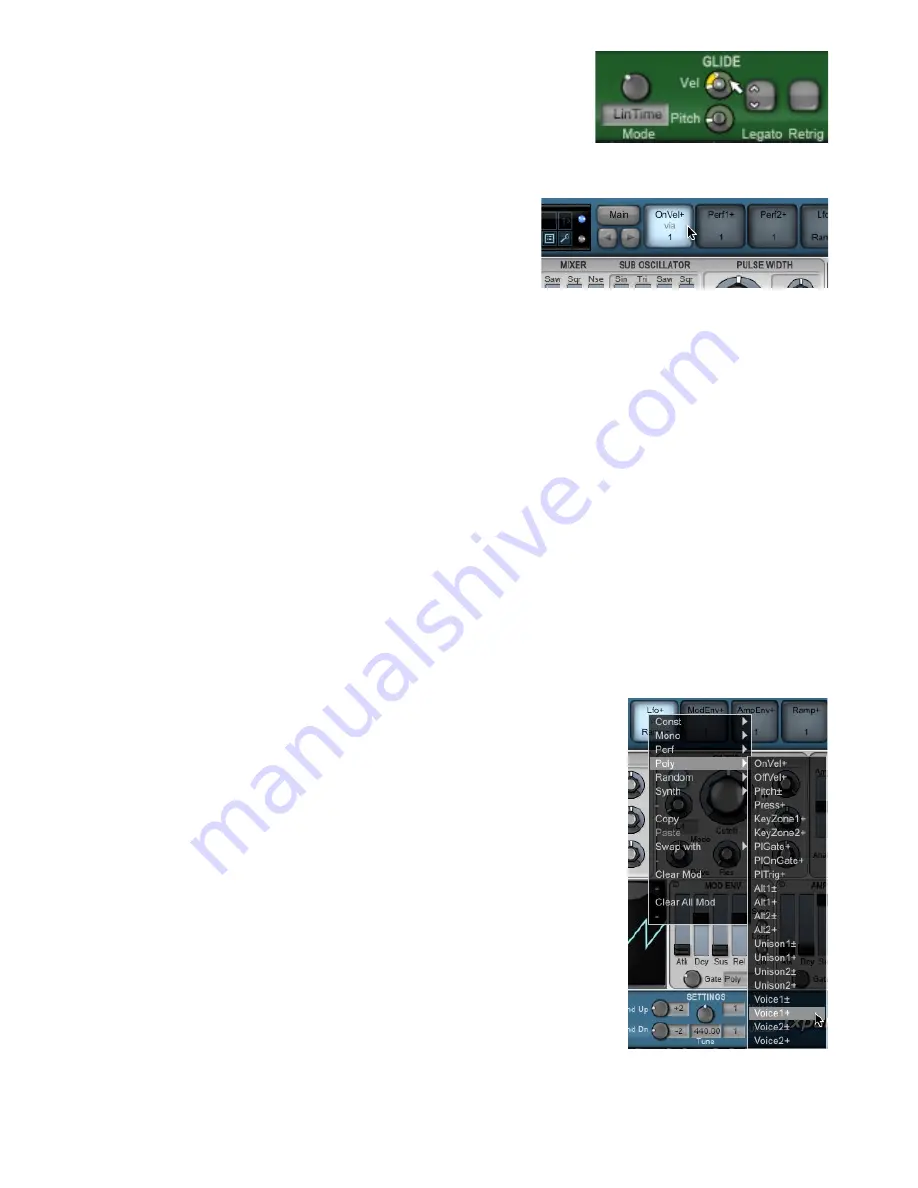
6
7:6 Glide, voices and unison
Glide
All the synths in DCAM: Synth Squad feature 2 types of Glide.
Pitch (Pitch Glide)
The
Pitch Glide
control sets the glide time towards the pitch of new note events.
This is the Glide control you will have seen on virtually all classic analogue monosynths. It smooths pitch control signals
from the keyboard, meaning that the pitch that you hear ‘glides’ up or down to the next note.
Vel (Velocity Glide)
The
Vel Glide
control sets the glide time towards new OnVel modulation
depths on each key-on event.
It utilizes the fact that key-on velocity is one of the most immediate
performance controllers on modern controller keyboards. Velocity Glide
offers a means of injecting life into a synth part without having to manipulate any additional performance controller.
For example, if you set up the OnVel+ TransMod source to increase the filter cutoff, playing a harder note after a soft note
would cause the cutoff frequency to glide to the higher value over the
Vel Glide
time period. If the Vel Glide control is set
to zero, the cutoff frequency is fully modulated as soon as the new harder note is played.
Modulation of Glide times
Pitch Glide
and
Vel Glide
times can be modulated using the TransMod system – they are the only controls in this area of
the synths’ interfaces that can be modulated.
Other parameters that affect Glide
As well as the
Pitch Glide
and
Vel Glide
time controls, several other controls in the Glide controls section also have an
effect on Glide behaviour (see sections 6:3 and 7:6 for full details of the Glide controls area of the interface).
• Legato
If enabled, glides occur only when 2 notes overlap (often known as ‘fingered portamento’). If it is disabled, glides always
occur regardless of how the input notes are positioned.
• Retrig
The
Retrig
button allows you to re-gate envelopes and other modulators during legato pitch glides.
• Mode
The Glide
Mode
control changes the glide response between ‘LinearTime’, ‘LinearRate’, and 2 exponential settings.
Using Glide in Amber
Amber’s paraphonic architecture means that voice-based pitch glide is not possible during conventional 1-voice
paraphonic usage. This is because all notes in the keyboard range are constantly generated at exact pitch.
However, you can still use glide in the TransMod system for modulating other parameters polyphonically (monophonic for
each voice). Use the Pitch TransMod source for utilizing keyboard pitch glides as a control signal.
Voices and Unison
Voice sources allow you to set up polyphonic modulation effects that vary according to
the number of active voices. Active voice counts are converted into a set of values from
-1 to 1 (bi-polar) and 0 to 1(uni-polar) . Each source is provided in 2 different varieties
of value distribution between the minimum and maximum.
The Unison sources allow any parameter to be varied across unison voices – not just
the pitch detuning found in classic synths. The Alt sources output alternating values for
each voice used in sequence.
Voice card manipulation in classic polysynths
Certain Oberheim polysynths such as the OB-8 featured trim pots for the pan position
of each voice, and many polysynths with individual voice cards had trim pots on each
card that could be manipulated to detune each voice, for example. Unison and voice
modulation in the TransMod system allows you to go way beyond these techniques to
create some startling effects, full of movement and variation. You can even mimic the
kind of voice variation found on old Oberheim SEM-based polysynths, which allowed
the programming of a totally different patch for each voice.
Examples for using voice and unison TransMod sources
• Modulate the
Pan
control for a stereo spread of voices during chords or unison notes.
• Subtle voice and unison modulation on envelope, filter, osc pitch and other controls
can result in more variation during performances, and emulate the slightly uneven,
unpredictable feel of a vintage synthesizer with slightly differing voice cards.
• Use the
Load to Mod Slot
function in a slot with a voice or unison source for wildly varied, dynamic sounds.
• Modulate
Pitch Glide
and
Vel Glide
times with a voice source to give each voice its own glide time.
• Use voice, unison and alternating sources as scalers on other modulation sources to inject more variation into them.
Summary of Contents for DCAM SYNTH SQUAD
Page 1: ......
Page 2: ......
Page 26: ...26 Shaper Filter Amp sections...
Page 109: ......
Page 110: ......
















































